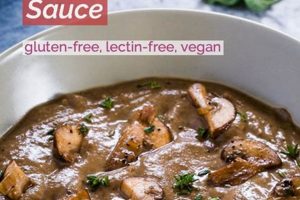Plant-based pasta toppings, formulated to provide a significant source of protein, represent a growing category within the food sector. These sauces offer a complete meal option, appealing to individuals adhering to vegan dietary restrictions while simultaneously seeking to increase their protein consumption. Examples include sauces based on lentils, beans, nuts, or fortified with plant-based protein isolates.
The appeal of these protein-rich, plant-derived sauces stems from several factors. They address the nutritional needs of vegans and vegetarians who may find it challenging to consume adequate protein. Furthermore, they cater to an increasing awareness of the environmental impact of animal agriculture, offering a more sustainable alternative to traditional meat-based sauces. Historically, Italian sauces relied heavily on animal products; the shift toward plant-based options signifies a notable evolution in culinary practices.
The subsequent discussion will explore the nutritional profile, ingredient composition, culinary applications, and market trends associated with these protein-enhanced, plant-based pasta accompaniments, providing a comprehensive overview of their role in modern diets.
Enhancing Plant-Based Pasta Dishes
The following are recommendations designed to maximize the protein content and nutritional value of vegan pasta sauces, contributing to a more balanced and satisfying meal.
Tip 1: Utilize Legume-Based Sauces: Incorporate sauces crafted from lentils, chickpeas, or black beans. These legumes provide a substantial protein boost compared to traditional tomato-based sauces. Example: A lentil bolognese can significantly elevate the protein content of a pasta dish.
Tip 2: Integrate Tofu or Tempeh: Crumble firm tofu or tempeh and saut it with aromatic vegetables before adding it to the sauce. These soy-based products are complete proteins and readily absorb flavors. Ensure excess moisture is removed to improve texture.
Tip 3: Employ Nut and Seed Butters: Introduce nut or seed butters, such as almond butter or tahini, for a creamy texture and added protein. These should be used sparingly, as they are calorie-dense. A small amount can greatly enhance the nutritional profile and flavor complexity.
Tip 4: Fortify with Nutritional Yeast: Add nutritional yeast to the sauce. It not only contributes a cheesy flavor but is also a source of B vitamins and protein. A few tablespoons can enhance the sauce’s overall nutritional value.
Tip 5: Include Hemp Seeds or Chia Seeds: Sprinkle hemp seeds or chia seeds into the sauce during the final stages of cooking. These seeds are rich in protein, omega-3 fatty acids, and fiber. They also add a subtle textural element.
Tip 6: Combine with High-Protein Vegetables: Supplement the sauce with vegetables known for their protein content, such as edamame, peas, or spinach. These additions contribute to a more nutrient-rich and balanced meal.
Tip 7: Optimize Serving Size: Adjust portion sizes to align with individual protein requirements. A larger serving of a protein-rich sauce will naturally increase the overall protein intake of the meal.
By implementing these strategies, individuals can create vegan pasta sauces that not only satisfy culinary preferences but also contribute significantly to their daily protein intake, supporting overall health and well-being.
The subsequent sections will delve into specific recipes and further explore the diverse applications of these protein-enhanced, plant-based pasta sauces.
1. Legume Base
The presence of a legume base is fundamental to defining a “high protein pasta sauce vegan.” Legumes, encompassing lentils, beans (such as kidney, cannellini, or black beans), and chickpeas, inherently possess a significantly higher protein content compared to traditional tomato-based sauces or cream-based alternatives. This characteristic makes them a foundational element for achieving the “high protein” claim. The impact is direct: the inclusion of a substantial quantity of pureed or textured legumes provides the primary protein source, negating the need for animal-derived ingredients while still delivering a nutritionally valuable product. For example, a sauce composed primarily of red lentils, simmered with vegetables and spices, can readily offer 15-20 grams of protein per serving. This is a markedly higher value compared to standard marinara sauces, which typically offer only 2-3 grams of protein.
The practical importance of understanding this connection lies in recipe formulation and product development. Manufacturers and home cooks alike can strategically select specific legumes based on their protein density, flavor profile, and textural properties to create a sauce that is both nutritionally sound and palatable. Furthermore, the choice of legume impacts the overall carbohydrate content and fiber content of the sauce, influencing its glycemic index and satiety factor. The process of incorporating legumes, whether as a smooth puree or a textured component, requires consideration of cooking times and moisture levels to achieve the desired consistency and prevent the sauce from becoming overly thick or dry. This also affects the overall palatability which is essential to the product’s success.
In summary, the legume base is not merely an ingredient; it is the structural and nutritional cornerstone of a “high protein pasta sauce vegan.” Its selection and preparation dictate the protein content, flavor, texture, and overall nutritional value of the final product. While other ingredients contribute to the sauce’s complexity, the legume component provides the essential protein foundation, allowing it to function as a complete and satisfying meal component for individuals following a vegan or plant-based diet. Challenges in achieving the desired protein content through only legumes can arise if taste or texture is compromised and must be addressed with careful formulation.
2. Protein Isolates
Protein isolates represent a critical component in augmenting the protein content of plant-based pasta sauces. These concentrated forms of protein, typically derived from soy, pea, rice, or other plant sources, serve to elevate the overall protein levels beyond what is naturally achievable with legumes and vegetables alone. Without the addition of protein isolates, attaining a designation as “high protein” becomes substantially more challenging, necessitating significantly larger serving sizes or compromising palatability through excessive reliance on other protein-rich ingredients like nuts or seeds. Consider, for instance, a sauce formulated with lentils and tomatoes; while lentils contribute protein, the addition of pea protein isolate can effectively double the protein content per serving, thereby meeting consumer expectations for a high-protein product. The usage addresses dietary needs and market demands.
The practical application of protein isolates extends beyond simply increasing protein percentages. Their incorporation influences the texture and consistency of the sauce. Some isolates, like soy protein isolate, possess emulsifying properties, which can enhance the sauce’s smoothness and prevent separation. Others, like rice protein isolate, may impart a slightly gritty texture if not properly processed or integrated. Therefore, careful consideration must be given to the type and quantity of isolate used, ensuring it complements the other ingredients and achieves the desired sensory attributes. Furthermore, the sourcing and processing methods of protein isolates bear scrutiny. Consumers increasingly prioritize products derived from sustainable and non-GMO sources, prompting manufacturers to seek out isolates that meet these criteria. The choice of isolate also impacts the sauce’s amino acid profile. While plant-based proteins are generally considered incomplete, combining different isolates can provide a more comprehensive amino acid profile, closer to that of animal-derived proteins. The impact on nutritional values is substantial.
In conclusion, protein isolates are indispensable in the formulation of plant-based pasta sauces aiming for high-protein status. Their strategic inclusion enables manufacturers to meet nutritional targets while maintaining desirable taste and texture characteristics. Challenges remain in optimizing the selection and integration of these isolates to achieve optimal sensory and nutritional outcomes, reflecting evolving consumer preferences and sustainability concerns. The integration is essential for maximizing protein yield without compromising quality.
3. Nutritional Yeast
Nutritional yeast plays a multifaceted role in the formulation of plant-based pasta sauces designed to be high in protein. Its contribution extends beyond mere flavoring, encompassing both nutritional enhancement and textural modification.
- Protein Source
Nutritional yeast is, itself, a source of complete protein, containing all nine essential amino acids. While the protein content of nutritional yeast is not as concentrated as that of protein isolates, its inclusion contributes to the overall protein density of the sauce. For instance, a sauce utilizing lentils as a primary protein source can be supplemented with nutritional yeast to further elevate the protein level per serving, aiding in achieving the “high protein” designation.
- Flavor Enhancement
One of nutritional yeast’s most notable attributes is its savory, umami flavor, often described as cheesy or nutty. This characteristic is particularly valuable in vegan cooking, where replicating the flavor profiles of dairy-based sauces can be challenging. Nutritional yeast provides a natural and plant-based way to add depth of flavor to pasta sauces, mimicking the richness of Parmesan cheese without the need for animal products. A sauce utilizing pureed cashews for creaminess can be enhanced with nutritional yeast to create a flavor reminiscent of Alfredo sauce.
- Vitamin Fortification
Many commercially available varieties of nutritional yeast are fortified with B vitamins, including vitamin B12, which is often lacking in vegan diets. By incorporating fortified nutritional yeast into a high-protein plant-based pasta sauce, it addresses multiple nutritional needs simultaneously. This synergistic effect enhances the sauce’s appeal to health-conscious consumers seeking a convenient and nutritionally complete meal option.
- Texture and Consistency
Nutritional yeast can contribute to the texture of a pasta sauce, providing a slight thickening effect when incorporated. This is due to the presence of cell wall components that absorb moisture and contribute to the sauce’s viscosity. In sauces with a thinner consistency, the addition of nutritional yeast can improve the overall mouthfeel and create a more satisfying eating experience.
The integration of nutritional yeast into high-protein, plant-based pasta sauces underscores its versatility as a functional ingredient. Its contributions to protein content, flavor, vitamin fortification, and texture coalesce to create a product that aligns with the nutritional and culinary preferences of a growing segment of consumers. However, it is crucial to consider potential limitations. The flavor of nutritional yeast can be polarizing, and excessive amounts may result in an overwhelming or undesirable taste. Finding the optimal balance is crucial to crafting a palatable and nutritionally balanced sauce.
4. Amino Acid Profile
The amino acid profile is a critical determinant of the nutritional quality of any protein source, including those utilized in “high protein pasta sauce vegan.” Protein is composed of amino acids, some of which are essential, meaning they cannot be synthesized by the human body and must be obtained through diet. A complete protein contains all nine essential amino acids in adequate proportions. Plant-based proteins, individually, are often incomplete, lacking or having low amounts of one or more essential amino acids. Therefore, formulating a vegan pasta sauce with a high protein content necessitates careful consideration of the amino acid profile to ensure it provides a balanced and nutritionally valuable protein source. The cause-and-effect relationship is direct: an inadequate amino acid profile diminishes the protein’s usability by the body, regardless of the total protein quantity. For example, a sauce relying solely on pea protein may be limited by its methionine content, while a sauce based primarily on brown rice protein may be deficient in lysine.
The practical significance of understanding the amino acid profile lies in the strategic selection and combination of plant-based protein sources. Manufacturers and home cooks alike can leverage the principle of protein complementation to create sauces with a more complete amino acid profile. This involves combining protein sources with complementary amino acid compositions. For instance, pairing legumes (often rich in lysine but lower in methionine and cysteine) with grains (often rich in methionine and cysteine but lower in lysine) can result in a combined protein source that is more nutritionally complete than either ingredient alone. Examples of such combinations in vegan pasta sauces include lentil and quinoa, black bean and corn, or chickpea and brown rice. Moreover, some plant-based protein isolates, such as soy protein isolate, are considered complete proteins, offering a convenient way to enhance the amino acid profile of a sauce. The impact of thoughtful formulation is evident in the enhanced nutritional value and potential health benefits of the final product.
In summary, the amino acid profile is a non-negotiable consideration in the development of “high protein pasta sauce vegan.” A focus solely on the total protein content without addressing the amino acid composition can result in a product with limited nutritional value. By strategically combining plant-based protein sources to achieve protein complementation, a vegan pasta sauce can provide a complete and high-quality protein source that supports optimal health and well-being. Challenges may arise in accurately assessing the amino acid profile of complex mixtures, requiring careful analysis and potentially necessitating the use of amino acid scoring methods. The ultimate goal is to create a palatable and protein-rich sauce that delivers a full spectrum of essential amino acids, contributing to a nutritionally sound vegan diet.
5. Fiber Content
Fiber content is a significant attribute of high-protein, plant-based pasta sauces, influencing both their nutritional value and physiological effects. Its presence distinguishes these sauces from traditional, often fiber-deficient, alternatives.
- Source of Dietary Fiber
The primary source of fiber in these sauces is typically derived from the plant-based ingredients themselves, such as legumes, vegetables, and whole grains (if included). Legumes, like lentils and beans, are particularly rich in both soluble and insoluble fiber. Vegetables, such as tomatoes, onions, and peppers, contribute varying amounts of fiber depending on the type and quantity used. The presence of these ingredients inherently increases the fiber content compared to sauces primarily composed of processed tomato products.
- Impact on Satiety
Dietary fiber plays a crucial role in promoting satiety, the feeling of fullness and satisfaction after eating. High-fiber foods slow gastric emptying and increase the volume of food in the digestive tract, contributing to a prolonged sense of fullness. This effect can be particularly beneficial in the context of a pasta meal, which can often be high in refined carbohydrates and relatively low in fiber. By incorporating a high-fiber pasta sauce, the overall satiety of the meal is increased, potentially leading to reduced calorie intake and improved weight management.
- Influence on Blood Sugar Levels
Soluble fiber, in particular, has been shown to have a beneficial effect on blood sugar levels. It slows the absorption of glucose from the small intestine, preventing rapid spikes in blood sugar after a meal. This is especially important for individuals with diabetes or insulin resistance, who need to carefully manage their blood sugar levels. The fiber content of high-protein, plant-based pasta sauces can help to mitigate the glycemic impact of the pasta itself, resulting in more stable blood sugar levels.
- Contribution to Digestive Health
Both soluble and insoluble fiber contribute to healthy digestive function. Insoluble fiber adds bulk to the stool and promotes regular bowel movements, preventing constipation. Soluble fiber can be fermented by gut bacteria, producing beneficial short-chain fatty acids that nourish the colonocytes and support a healthy gut microbiome. A high-fiber pasta sauce can therefore contribute to overall digestive health and well-being.
The interplay between fiber content and other nutritional attributes, such as protein and complex carbohydrates, underscores the value proposition of high-protein, plant-based pasta sauces. They offer a more nutritionally complete and physiologically beneficial alternative to traditional sauces, aligning with consumer preferences for healthier and more sustainable food choices. The addition of fiber increases the overall nutritional profile, making it a beneficial choice.
6. Sustainable Sourcing
Sustainable sourcing constitutes an integral aspect of high-protein, plant-based pasta sauces, reflecting a commitment to minimizing environmental impact and promoting ethical labor practices throughout the supply chain.
- Ingredient Origin and Traceability
Sustainable sourcing necessitates knowing the origin of each ingredient, including legumes, vegetables, and protein isolates. Traceability systems enable verification of farming practices, ensuring compliance with environmental standards and fair labor conditions. For instance, sourcing lentils from farms employing water-efficient irrigation techniques and avoiding synthetic pesticides exemplifies sustainable practice. Failure to track ingredient origins increases the risk of supporting unsustainable or unethical production methods.
- Environmental Impact Mitigation
Sustainable sourcing prioritizes minimizing the environmental footprint associated with ingredient production and transportation. This includes reducing greenhouse gas emissions, conserving water resources, and protecting biodiversity. Utilizing plant-based protein isolates derived from crops grown with regenerative agriculture practices, which enhance soil health and carbon sequestration, contributes to environmental sustainability. Conversely, relying on ingredients sourced from regions experiencing deforestation or water scarcity undermines environmental integrity.
- Ethical Labor Practices
Sustainable sourcing mandates adherence to fair labor standards throughout the supply chain. This encompasses ensuring safe working conditions, providing fair wages, and prohibiting forced labor and child labor. Verifying that legume farmers receive fair prices for their crops and that workers in protein isolate processing plants are treated ethically is crucial for upholding social responsibility. Neglecting labor standards risks perpetuating exploitation and undermining social equity.
- Packaging and Waste Reduction
Sustainable sourcing extends to packaging materials and waste management. Utilizing recyclable or compostable packaging reduces landfill waste and minimizes environmental pollution. Implementing closed-loop systems, where packaging materials are collected and reused, further enhances sustainability. Employing packaging derived from non-renewable resources and neglecting waste management practices contributes to environmental degradation.
These facets of sustainable sourcing collectively contribute to the overall sustainability profile of high-protein, plant-based pasta sauces. They reflect a growing consumer demand for products that are not only nutritious and delicious but also ethically and environmentally responsible. Failure to prioritize sustainable sourcing practices undermines the long-term viability of the food system and disregards the interconnectedness of environmental, social, and economic considerations.
Frequently Asked Questions
The following addresses common inquiries regarding plant-based pasta sauces formulated to provide a significant source of protein.
Question 1: Does “high protein pasta sauce vegan” provide a complete protein source?
The completeness of the protein source depends on the formulation. While individual plant-based proteins may lack certain essential amino acids, strategic combinations, such as legumes and grains, or the inclusion of complete protein sources like soy protein isolate, can create a complete protein profile.
Question 2: What is the typical protein content per serving in a “high protein pasta sauce vegan”?
The protein content varies by brand and recipe. However, a sauce marketed as “high protein” generally contains at least 10-15 grams of protein per serving, significantly exceeding the protein content of traditional marinara or tomato-based sauces.
Question 3: Are there any common allergens present in “high protein pasta sauce vegan”?
Common allergens may include soy (from soy protein isolate), nuts (from nut butters), or gluten (if certain thickeners or ingredients are used). Individuals with allergies should carefully review ingredient lists before consumption.
Question 4: How does the fiber content of “high protein pasta sauce vegan” compare to traditional sauces?
These sauces generally exhibit a higher fiber content due to the inclusion of legumes, vegetables, and whole grains. Increased fiber contributes to satiety and improved digestive health.
Question 5: Can “high protein pasta sauce vegan” be incorporated into recipes beyond pasta dishes?
Yes, these sauces can be utilized in various culinary applications, including as a base for soups, stews, chili, or as a topping for baked potatoes and vegetables.
Question 6: What certifications should be sought when purchasing “high protein pasta sauce vegan”?
Look for certifications such as Certified Vegan, Non-GMO Project Verified, and certifications related to sustainable sourcing practices to ensure adherence to specific ethical and environmental standards.
The preceding questions and answers offer insights into key aspects of high-protein, plant-based pasta sauces, aiding in informed consumer choices.
The subsequent sections will provide information on recipe adaptation and storage guidelines for these sauces.
Conclusion
The preceding exploration has illuminated the multifaceted characteristics of high protein pasta sauce vegan. Emphasis has been placed on its nutritional composition, ingredient sourcing, and culinary applications. The significance of complete protein sources, fiber content, and sustainable practices in the production of these sauces has been thoroughly addressed. Understanding these elements is crucial for informed dietary choices within the context of plant-based nutrition.
The continued development and refinement of plant-based protein sources hold significant potential for enhancing both individual health and the sustainability of the food system. Further research and innovation in this sector are warranted to optimize the nutritional profiles and environmental impact of high protein pasta sauce vegan, thereby contributing to a more resilient and ethical food landscape.







